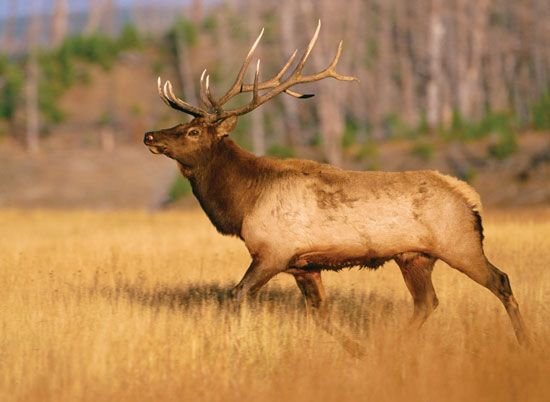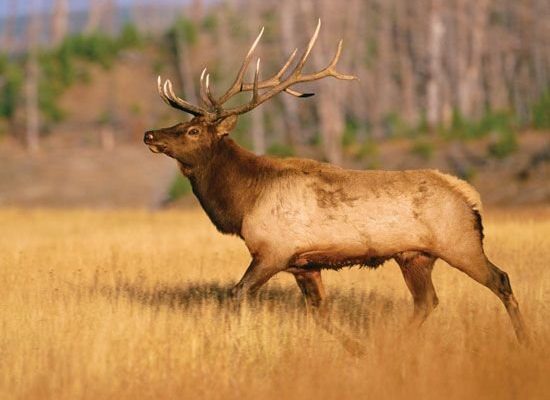
Wapitis are known for their impressive antlers and distinctive calls, but there’s so much more to learn about them. From their habitat to their fascinating social structures, wapiti stand out among the vast array of wildlife. So grab a coffee, and let’s dive into some captivating facts about these remarkable creatures!
1. Wapiti Are One of the Largest Species in the Deer Family
Wapiti are truly impressive in size. Standing up to about five feet at the shoulder and weighing anywhere from 400 to 1,100 pounds, they’re no small fry! Honestly, when you see one up close, you can’t help but be awed by their sheer bulk. Imagine a tall horse with a thick, sturdy frame—this is pretty much what a wapiti looks like.
Their weight can vary significantly depending on the subspecies and the region in which they live. For instance, the Rocky Mountain wapiti is generally larger than its Eastern counterpart. This size not only helps them survive in various climates but also contributes to their role within the ecosystem as key herbivores. Their grazing habits help shape the landscapes they inhabit, keeping plant growth in check.
The Role of Size in Survival
Being larger also has its perks. Wapiti can fend off smaller predators, and their size is an advantage during mating season, where dominant males fight for the right to mate with females. It’s nature’s version of the heavyweight championship! Size matters because it gives them a competitive edge, which is vital for ensuring the survival of their species.
2. Their Antlers Are Truly a Sight to Behold
One of the standout features of wapiti is their impressive antlers. Growing up to four feet long, these magnificent structures can weigh as much as 40 pounds! Imagine carrying around a whole bag of flour on your head—that’s basically what these males do every year.
Wapiti shed their antlers every winter, and by spring, they regrow them in a remarkable process. The new antlers start as soft, fuzzy “velvet” that supplies blood and nutrients, making them grow faster. Here’s the thing—once summer hits, the velvet dries up and peels away, revealing the hard, polished antlers that help in attracting mates during the rutting season.
The Antler Growth Cycle
The cycle of antler growth is fascinating. Each year, as they mature, wapiti can grow larger and more impressive antlers. This is why during mating season, you often hear hearty bugling calls and see dramatic displays of strength between competing males. These antlers aren’t just for show; they are a crucial part of their survival strategy during mating.
3. Wapiti Have Unique Social Structures
You might be surprised to learn that wapiti are not solitary creatures. Instead, they exhibit interesting social behaviors. Typically, they live in herds that range from a few individuals to over a hundred. Isn’t that cool? These groups are often made up of females and their young, while males tend to be more solitary, especially outside the mating season.
During the rutting season, however, males join herds to mate. They engage in competitors’ displays of strength, which often leads to dramatic confrontations. It’s like a live-action drama playing out in nature, where you can see social dynamics in real-time!
How Social Structures Impact Their Lives
The social structure of wapiti helps them thrive. By living in groups, they can protect themselves from predators, share information about food sources, and provide nurturing environments for young calves. This strong sense of community showcases the complexity of their social interactions—something we often admire in our own lives.
4. Their Habitat is Diverse
Wapiti are adaptable creatures, thriving in various habitats. You’ll find them in forests, grasslands, and even mountainous regions. They enjoy environments with open spaces where they can graze on grasses, leaves, and shrubs. Think of them as the nature-loving explorers of the deer family, making themselves at home in different landscapes.
In the western U.S. and Canada, wapiti are prominent in national parks like Yellowstone and Banff. Here’s the thing: these areas provide a perfect combination of food sources and space for roaming, which is essential for their well-being and survival.
The Importance of Their Habitat
Conservation efforts focus on maintaining and protecting these habitats to ensure wapiti populations can thrive. When their environments are threatened, it can lead to issues like overcrowding or competition for limited resources. Protecting their habitats means protecting the wapiti, which is crucial for maintaining healthy ecosystems.
5. Wapiti Communication Is Quite Fascinating
Wapiti communicate in a variety of ways. From vocalizations to body language, they have developed a rich set of signals to convey their feelings. You might be wondering how they manage it all. Their most notable vocalization is the “bugle,” a haunting sound that echoes through the forests. This bugle serves multiple purposes, from attracting mates to asserting dominance.
Imagine being in a dense forest and hearing a loud, eerie call echoing all around you—it’s both beautiful and a little unsettling at the same time. During mating season, the calls become more frequent as males compete to woo females, creating a lively atmosphere filled with sounds of nature.
Body Language Matters Too
In addition to vocalizations, wapiti use body language to communicate with each other. Postures, movements, and tail positions can indicate everything from alarm to aggression. This sophisticated communication system helps them navigate their social lives and respond to threats more effectively. It’s fascinating to see how they express themselves beyond just vocal sounds!
6. Wapiti Play a Crucial Role in Their Ecosystems
Wapiti are not just beautiful creatures; they play a vital role in the ecosystems they inhabit. By grazing on various plants, they help maintain the balance between different species. You might think of them as natural landscapers, shaping their environments through their eating habits.
By feeding on grasses and shrubs, wapiti help promote the growth of certain plant species while preventing others from becoming too dominant. This grazing behavior promotes biodiversity, allowing various plants and animals to thrive together.
Impacts on Other Wildlife
Their grazing also creates open spaces that benefit other wildlife, making it easier for different animals to find food and shelter. This means that wapiti don’t just support their own species; they help maintain the overall health of their entire ecosystem. It’s a beautiful example of how interconnected nature really is!
7. They Are Social Grazers
Wapiti are known as social grazers, often seen in herds while feeding. They have a unique way of foraging that includes both grazing on grasses and browsing on taller vegetation. This diverse diet allows them to adapt to varying food sources throughout the seasons.
When you see a group of wapiti grazing together, it’s not just a leisurely meal; it’s a social event! They often communicate about food availability and share the grazing spots, working together to ensure everyone gets enough to eat.
The Benefits of Social Grazing
Grazing in groups has its perks. It allows wapiti to stay vigilant against predators while they eat, as there’s safety in numbers. Plus, they can enjoy higher quality food when they manage their foraging strategies effectively. This cooperative feeding behavior showcases their intelligence and adaptability in the wild.
8. Conservation Efforts Are Vital
Unfortunately, wapiti populations have faced challenges over the years, including habitat loss and hunting pressures. Conservation efforts are crucial for maintaining their numbers and ensuring they continue to thrive in the wild. Various organizations are dedicated to protecting their habitats and promoting sustainable practices.
You might be wondering what these efforts look like. They can include habitat restoration, monitoring populations, and creating protected areas like national parks. By focusing on conservation, we can help ensure that wapiti remain a vital part of our ecosystems for generations to come.
How You Can Help
You can also contribute to these efforts. Supporting organizations that work to protect wildlife and their habitats, as well as spreading awareness about the importance of conservation, goes a long way. Just like any other part of our environment, wapiti need our help to thrive and maintain their role in nature.
9. Wapiti Have a Unique Seasonal Behavior
Throughout the year, wapiti exhibit fascinating seasonal behaviors. In the spring and summer, they are often more active and social, spending time in herds and taking advantage of abundant food sources. As fall approaches, things start to change. This is when the mating season kicks in, and you can observe some dramatic behavior!
During the rut, males become more aggressive as they compete for female attention. This is where their impressive antlers come into play, as they engage in fierce battles. The drama of the rutting season is a spectacular sight to witness!
Winter Adaptations
As winter sets in, wapiti adapt to the challenges of colder weather. Their coats thicken to provide warmth, and they shift their diets to include more woody vegetation. You might see them digging through the snow to reach hidden grasses. This adaptability ensures their survival even in harsh conditions.
10. Cultural Significance of Wapiti
Wapiti hold a significant place in many Native American cultures. They are often seen as symbols of strength and grace, and their presence is woven into various traditions and stories. You’ll find that many tribes have rich histories and relationships with wapiti, celebrating their importance through art and storytelling.
Their majestic appearance and roles in nature inspire respect and admiration. As a result, these animals are often featured in folklore and spiritual practices, further highlighting their significance beyond just being wildlife.
Modern-Day Appreciation
In addition to their cultural significance, wapiti attract wildlife enthusiasts and tourists alike. National parks and reserves provide opportunities to observe these magnificent creatures in their natural habitat. This appreciation helps to foster a deeper understanding of the importance of conservation and protecting their environments.
As you can see, wapiti are truly fascinating animals that contribute much to our ecosystems and cultural heritage. By learning about them, we can appreciate their importance and work towards ensuring their continued survival.
In conclusion, wapiti are more than just impressive mammals; they are key players in the balance of nature. From their stunning antlers to their unique social structures, understanding these animals can deepen our appreciation for the wildlife that shares our planet. So next time you think of wapiti, remember that they are not just beautiful creatures; they are vital to the world around us.

